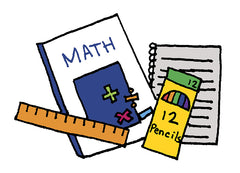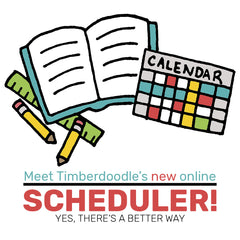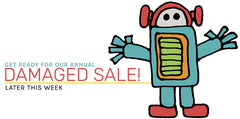The following is an older blog post, revised to reflect current Sonlight and Timberdoodle curriculum kits.
…I feel silly asking you this, because of course you are a Timberdoodle supporter :-). but can you give me any thoughts about trying to choose between Timberdoodle and Sonlight?
Michele
I’m happy to share my perspective, though of course, I know our curriculum much better than I know theirs, so you’ll want to keep that in mind!
We actually like Sonlight, and have friends using it. It isn’t for all families though, so how do you know which is best for you?
If you have used Sonlight in the past, my first question would be simply to ask why you are thinking about changing. Is there something that didn’t work out so well for your family? If Sonlight works well for you and your family can afford it, why not stay with it?
There are some similarities between our Timberdoodle curriculum kits and Sonlight’s curriculum packages, and some differences. Here is a smattering of contrasts and comparisons that may prove helpful.
Books
This is the most obvious difference and has a huge impact on the price of each package. Sonlight includes a ton of books, while we at Timberdoodle opt to rely more heavily on your local library and not your budget. The advantages of Sunlight’s approach are that you don’t have to think it through or remember to add them. The advantages of Timberdoodle’s approach are the lower cost and the ability to pick books best suited to your family’s standards/child’s interests. Timberdoodle also includes robust literature courses in 3rd-12th grade that contain the required reading in the text itself. More to the point, each grade has a fun reading challenge to complete that may be as rigorous or laid-back as you like. Challenges include such things as “Read a book with a fruit in the title” “Choose a book written by an author who uses an initial for his or her first name” etc. We love this because we are avid readers ourselves, and this keeps us from getting into a rut.
Math
Sonlight and Timberdoodle both use the renowned Math-U-See program.
Literature-Based or Practical/Charlotte Mason influenced approach?
Sonlight is a literature-based approach, with an emphasis on learning by reading. Timberdoodle is more practical and has a hands-on emphasis more in keeping with Charlotte Mason. Our goal is that the child learns how to learn, which is why our curriculum has such a focus on thinking skills. Sonlight emphasizes a broader exposure to different cultures, times and concepts through reading.
Teacher Led or Independent Study
While the beginning grades are always teacher intense until the child can manage their own reading, Timberdoodle emphasizes independent learning as soon as it is possible. While parents are encouraged to be as involved as they wish (in our family, absolutely everything was discussed, mostly informally, and we expect no less of our customers!), we feel that it is a benefit to both the student and the busy parent to have the child working independently as much and as early as possible. Sonlight emphasizes parental involvement throughout the grades with read-aloud books, formal discussions, etc.
Time
In third grade, for instance, Sonlight expects students to spend 3.5 – 4.5 hours a day, and teachers to spend 2-3 hours a day. Timberdoodle anticipates that most students will complete their work in 2-4 hours a day (depending on their focus and reading speed, as well as whether you’re opting for a 4- or 5-day school week). The actual teaching should take up to half an hour, depending on whether you would like your student to independently read science and history or you prefer to read that aloud. Depending on your child, you’ll be more involved than that answering questions and helping redirect the student, but it isn’t the same as planned teaching time.
Bible
Both Sonlight and Timberdoodle are owned by Christian families, and the curriculum reflects that. However, Sonlight includes a Bible portion in their curriculum, while Timberdoodle has opted not to. Sonlight’s preference of having it included makes it easy to include this most important subject, while our choice to leave it out means that families can move this topic from school to family devotions, and pick the approach that is best for their family.
Thinking Skills
Timberdoodle‘s curriculum kits have a tremendous emphasis on thinking skills and logic, using curriculum and hands-on tools like smart games. We consider it one of the most important subjects, and the curriculum choices reflect that. (Language Arts/Reading, Math and Thinking Skills are our big three.) Sonlight does include some critical thinking tools, but not with quite the same scope.
Age Range
Sonlight’s curriculum is available for preschool through highschool. Timberdoodle offers curriculum from 0-12th grade.
Complete Packages
Timberdoodle offers a complete package for each grade, baby-12th grade, with free and easy customization. Sonlight offers “All-Subjects Packages” for Kindergarten – Twelfth Grade and also offer customization.
Documentation
Sonlight comes with extensive documentation in the form of an Instructor’s Guide that “…tells you what to read and do each day, gives you extra notes to help you talk about any difficult subjects, suggests discussion questions to spur great conversations with your kids and helps you get the most from your books and timeline.” They also have a 3-week sample available online. Timberdoodle has opted for a much simpler handbook which gives you an overview of each subject and how to schedule it, along with an annual planning schedule and a weekly checklist for your student, the reading challenge, and perhaps best of all, access to our online custom scheduler. Our goal is to get you up and running within minutes with minimal prep or stress.
Charter School Editions
Sonlight’s sister company, BookShark, offers a charter school edition which is available for Pre-K through age 16. Timberdoodle’s charter school friendly kits are simply known as the non-religious editions and are available from 0-12th grade.
Conclusion
Both are great programs – but neither is perfect for everyone. Hopefully, this comparison will help you figure out what is best for your family! As always, I’d be delighted to help if you have any further questions.
 Skip to content
Skip to content





